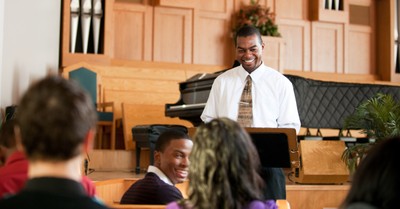In Defense of Marriage: The Unique Benefits of Traditional Marriage
- S. Michael Craven President, Center for Christ & Culture
- Updated May 04, 2021

Marriage is designed for sex
and sex is designed for marriage. Nonmarital sex ultimately harms the
individual and society. Marriage, as I have already shown, is also exclusively
heterosexual in that it conforms to the biological design for human sexuality
and fulfills the reproductive principle. While same-sex couples may enjoy an
emotional bond and engage in sexual acts, they are unable to achieve this
one-flesh union because there is no biological communion such as that achieved
through procreative acts. In the absence of this biological principle, sex
becomes merely instrumental for self-satisfying pleasure and therefore falls
into the same destructive category of self-centered acts that characterize all
nonmarital sex.
Any deviation from this proper relationship for sex (i.e., marriage), as well
as its proper biological design (i.e., heterosexual), is a perversion of human
sexuality; history demonstrates that such deviations will inevitably undo those
societal goods associated with marriage and the natural family.
So what are these “goods” that derive from marriage? According to the eminent
Married people live longer, are healthier, have fewer heart
attacks and other diseases, have fewer problems with alcohol, behave in less
risky ways, have more sex—and more satisfying sex—and become much more wealthy
than single people. (As quoted by Robert Browning in a book review of The
Case for Marriage: Why Married People are Happier, Healthier and Better Off
Financially by Linda Waite and Maggie Gallagher).
Regarding mortality, studies reveal that “mortality rates are 50 percent higher
for unmarried women and 250 percent higher for unmarried men than they are for
married women and men” (Waite and Gallagher, The Case for Marriage [
Mortality rates for homosexual men are even higher. According to a study that
appeared in the International Journal of Epidemiology, which examined
the homosexual community in Vancouver, Canada, “Life expectancy at age 20 years
for gay and bisexual men is 8 to 20 years less than for all men” (Robert S.
Hogg et al., “Modeling the Impact of HIV Disease on Mortality in Gay and
Bisexual Men,” International Journal of Epidemiology, 26 [1997]: 657).
Another overlooked benefit of marriage is that of physical security for women.
While some may want you to believe that marriage facilitates the oppression and
subjugation of women, the reality is that spousal abuse is not the primary
source of domestic abuse in this country; it is nonspousal abuse. According to
the National Crime Victimization Survey conducted by the US Department
of Justice, of all violent crimes against domestic partners (male/female) that
occurred between 1979 and 1987, boyfriends or ex-husbands commit the
overwhelming majority of crimes. In total, 20 percent of women report having
been assaulted by their partner. However, husbands presently living with their
wives committed only 9 percent of these crimes. The evidence overwhelmingly
demonstrates that being unmarried puts women at a much higher risk of
domestic abuse.
Abuse within male homosexual relationships is as high as 46 percent (“Domestic
Violence in Gay and Lesbian Couples,”
www.psychpage.com/gay/library/gay_lesbian_violence). Among lesbian couples,
some research shows that the lifetime prevalence of physical assault among
women living with female partners was 35.4 percent. Given that same-sex
“marriage” would exist in name only without its essential defining elements,
its application to homosexual couples would, most likely, not serve to arrest
the high rates of domestic abuse among gays.
To illustrate that marriage is unique and its benefits derive from a particular
social understanding that is beyond the mere fact of men and women living
together in a sexual relationship, consider cohabitation. Cohabiting couples
seldom accumulate wealth in the same way married couples do. They are far more
tentative about their relationship, less inclined to invest together in homes,
stocks, and furniture, and more likely to do such things as keep separate bank
accounts and take separate vacations (Waite and Gallagher, 110–123). And
finally, the physical and sexual abuse of children is much higher in cohabiting
families than in married families (Waite and Gallagher, 135).
Many believe that living together prior to marriage serves as an effective
testing ground, increasing a couple’s chances for a long-term, healthy
marriage. However, four decades of sociological evidence overwhelmingly
demonstrates that just the opposite is true. In fact, cohabitation not only
fails to prepare couples for marriage, but actually contributes to decreased
marital stability in the future. According to studies, couples that cohabitate
prior to marriage have substantially higher divorce rates, ranging from 50 to
100 percent higher (Axinn and Thorton, “The Relationship Between Cohabitation
and Divorce: Selectivity or Casual Influence?” Demography 29, 357–374).
Cohabitation is not related to marital happiness, but it is instead
related to lower levels of marital satisfaction, higher levels of marital
disagreement, and marital instability (Booth and Johnson, “Premarital
Cohabitation and Marital Success,” Journal of Family Issues 9, 261). The
dissolution rates of women who cohabit premaritally with their future spouses
are, on average, nearly 80 percent higher than the rates of those who do not
(Bennett, Blanc, and Bloom, “Commitment and the Modern Union: Assessing the
Link Between Premarital Cohabitation and Subsequent Marital Stability,” American
Sociological Review 53, 127–138).
One possible cause for the instability inherent in cohabitation is the lack of
social reinforcement for fidelity that is implicit in marriage. Research again
reveals that currently cohabitating and postmarital cohabitating individuals
are less committed to their present partner in regards to the possibility of
sexual encounters with others outside of the current relationship (Cunningham
and Antill, “Cohabitation and Marriage: Retrospective and Predictive
Comparisons,” Journal of Social and Personal Relationships 11, 89).
In regards to homosexual couples, the concept of fidelity is a popular myth. In
the book The Male Couple, the author reports that in a study of 156
males in homosexual relationships lasting from one to thirty-seven years, “Only
seven couples have a totally exclusive sexual relationship, and these men all
have been together for less than five years. Stated another way, all couples
with a relationship lasting more than five years have incorporated some
provision for outside sexual activity in their relationships” (McWhirter, The
Male Couple [Upper Saddle River, NJ: Prentice Hall] 252, 253).
Cohabitation among heterosexual couples is much closer to marriage—yet even
here we see the adverse affect this modification of marriage and the natural
family has had on the deterioration of the family and the loss of essential
societal benefits. In short, marriage and the natural family function as the
cornerstone of civilization; even the slightest deviation from this absolute
definition destabilizes this vital institution and begins to produce a series
of deleterious effects. Do we really believe that redefining marriage in even
more radical terms will somehow improve the situation?
© 2008 by S. Michael Craven
Comment on this article here
Subscribe to Michael's weekly commentary here
Subscribe to Michael's podcast here
S. Michael Craven is the founder and President of the Center for Christ &
Culture. Michael is the author of the groundbreaking book, Uncompromised
Faith: Overcoming Our Culturalized Christianity, published by Navpress and
scheduled for release January 2009. Michael's ministry is dedicated to renewal
within the Church and works to equip Christians with an intelligent and
thoroughly Christian approach to matters of culture in order to demonstrate the
relevance of Christianity to all of life. For more information on the Center
for Christ & Culture, the teaching ministry of S. Michael Craven, visit: www.battlefortruth.org
Michael lives in the




















